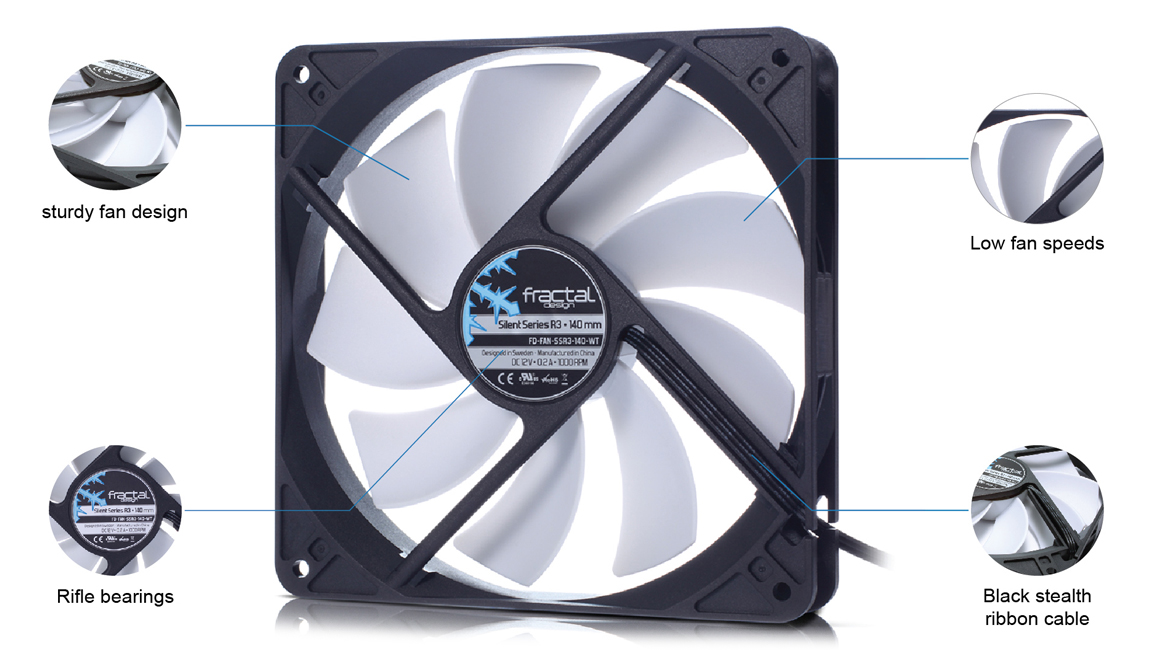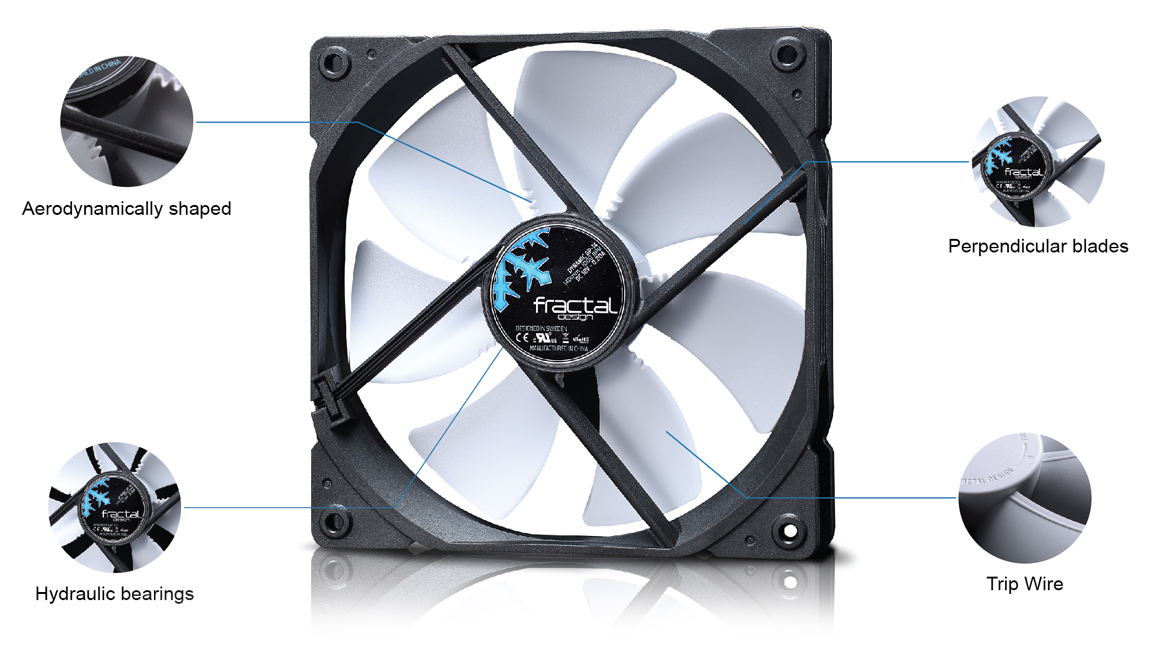Fractal Design's New Fans Promise Silence On A Budget
Fractal Design introduced not one, but two new series of fans to quench your thirst for silence.
In the world of case and system fans, it can be very difficult to stand out, so when a manufacturer has the guts to try to compete with existing players, we're often already (a little) impressed, regardless of whether the product is any good or not. Fractal Design is no stranger to making fans, but it has now introduced its Silent Series R3 fans and the Dynamic Series fans.
The Silent Series R3 fans will come in various sizes ranging from 40 mm through 140 mm and are built to offer silent, quality performance on a budget. They feature rifle bearings, low fan speeds (and therefore low noise), Fractal's signature black and white color scheme, and a sleek black ribbon cable. All of the fans have a 3-pin fan header (so no PWM support) and have an MTBF (Mean Time Between Failure) of 40,000 hours.
| Header Cell - Column 0 | Max RPM | Max Noise | Max Airflow | Price |
|---|---|---|---|---|
| 40 mm | 4000 RPM | 20.0 dBA | 3.6 CFM | $5.99 |
| 50 mm | 3500 RPM | 19.0 dBA | 6.8 CFM | $5.99 |
| 60 mm | 2500 RPM | 20.6 dBA | 13.3 CFM | $6.99 |
| 80 mm | 1600 RPM | 18.1 dBA | 20.2 CFM | $6.99 |
| 92 mm | 1500 RPM | 18.3 dBA | 24.4 CFM | $6.99 |
| 120 mm | 1200 RPM | 20.5 dBA | 46.5 CFM | $7.99 |
| 140 mm | 1000 RPM | 21.6 dBA | 56.1 CFM | $9.99 |
The Dynamic Series fans will only come in two sizes at launch, but they will also come in two different color patterns. The first is the standard black and white design, and the other is an all-black design. They target a slightly more silence-oriented audience. They spin at the same speed as their respective 120 mm and 140 mm Silent Series R3 fans, but they push a little more air at a lower noise level. Specifically, the 120 mm version will push up to 52.3 CFM while making up to 19.4 dBA of noise, while the 140 mm variant will push a respectable 68.4 CFM at a noise level of 18.9 dBA.
This better noise vs airflow ratio is accomplished by using a fluid hydraulic bearing with a counter-balancing magnet, a trip wire at the end of the blades, strator struts, and more. Despite all this, however, the fans don't have PWM support.
Pricing for the 120 mm Dynamic Series fan sits at $10.99, and the 140 mm version will go for $12.99. All of the new fans should be available in April.
Follow Niels Broekhuijsen @NBroekhuijsen. Follow us @tomshardware, on Facebook and on Google+.
Get Tom's Hardware's best news and in-depth reviews, straight to your inbox.
Niels Broekhuijsen is a Contributing Writer for Tom's Hardware US. He reviews cases, water cooling and pc builds.
-
falchard I still prefer my computer case to sound like the deck of an aircraft carrier with my Delta Electronic fans.Reply -
alextheblue Sounds like Noctua is still quite safe. Also, no PWM options in 2015? Odd. Even lowend boards typically have a couple of PWM connectors.Reply -
RCguitarist Cougar has had noctua beat in both price and performance for an eternity. Noctua products are overpriced for what they are. And pwm isnt needed anymore. Every decent motherboard comes with fan control software for all of the chassis fans and cpu fan. With 4 fans able to be set using custom fan speed graphs, pwm just isn't needed any more.Reply -
synphul Just what the market needs, more cheapy low quality under performing fans. Huge disappointment and way to cheapen their brand they've been working so hard at establishing. Granted they're inexpensive, but 40k hrs mtbf? Rifle bearings? 56cfm at nearly 22db? Sad.Reply
Likely yet another fan that will fail miserably when tasked with being mounted horizontally which is a major downfall for many fans. With so many top mounted exhaust designed cases with and without top mounted radiators, the choice for a functional fan in that position is very slim.
I'm not against 'affordable' fans but isn't the market already full of no names along with tons of low end lepas, enermax, tt, cm's, rosewill, apevia, masscool and on and on? Nothing new or innovative, or even reliable. Aerocool's ds, phanteks and cougars are all decent - until you mount them as bottom intake or top exhaust, then they all wobble, click, rattle and vibrate.
The thing with even a good company releasing a cheapy product is it drags down their reputation. Even if they stopped with these and never did it again, I bet in conversation years down the road it will pop up 'oh, remember those junk fans xyz company put out?'. Not good. -
ajac09 trying to silence my pc connected to the TV.. wonder if I should just invest in a silent case. dont care about the size just the sound though I think its the power supply making all the noise time for a silent one lolReply -
synphul Is it a small case like a mini atx or htpc or is it a regular desktop mid/full tower? If it's a regular desktop and you have room for additional fans, just pick up some decent quality fans and either use a fan controller or voltage reducer adapters to slightly undervolt them. Provided they produce decent airflow, more fans can move the same or more air at much lower speeds than fewer fans at higher speeds (which cause excessive noise). If you can, definitely try to isolate the noisier fan(s) as it only takes one to spoil the bunch.Reply
Another good way to pick out a fan, check out several you're interested in on youtube so you can listen to them running. It won't give you exact sound in terms of volume in decibels since the vids may differ in mic sensitivity or your pc volume can be turned up/down. What it will do is hopefully at least give you an idea of the tonality or pitch of the fan(s). Decibels, even if all printed specs were 100% accurate which they aren't, only measures sound pressure. What it doesn't measure is pitch or tone which also affect the way you perceive a sound. A lower pitched 'hum' at 22dba may 'seem' quieter than a higher pitched 'whine' at 20dba. Each person is slightly different in what noises irritate them, but sound quality is as important as 'loudness'. -
larkspur Reply
The advantage of PWM vs voltage regulated(VR) is that PWM fans have a greater range of rpm (in the fan's lower rpm). You can't(shouldn't anyway) run a VR fan below its starting voltage. The starting voltage varies with computer fan designs but is usually either 5v or 7v. This limits how slowly a VR fan can spin. To put it simply - PWM fans can spin much more slowly than VR fans without risk of burning up the motor. When you want a quiet system while idling, a few hundred RPM slower can make a big difference - particularly if you have a lot of fans. PWM is very much needed if you want to optimize your computer's acoustic footprint while under low load or idling.15309753 said:And pwm isnt needed anymore. Every decent motherboard comes with fan control software for all of the chassis fans and cpu fan. With 4 fans able to be set using custom fan speed graphs, pwm just isn't needed any more.



